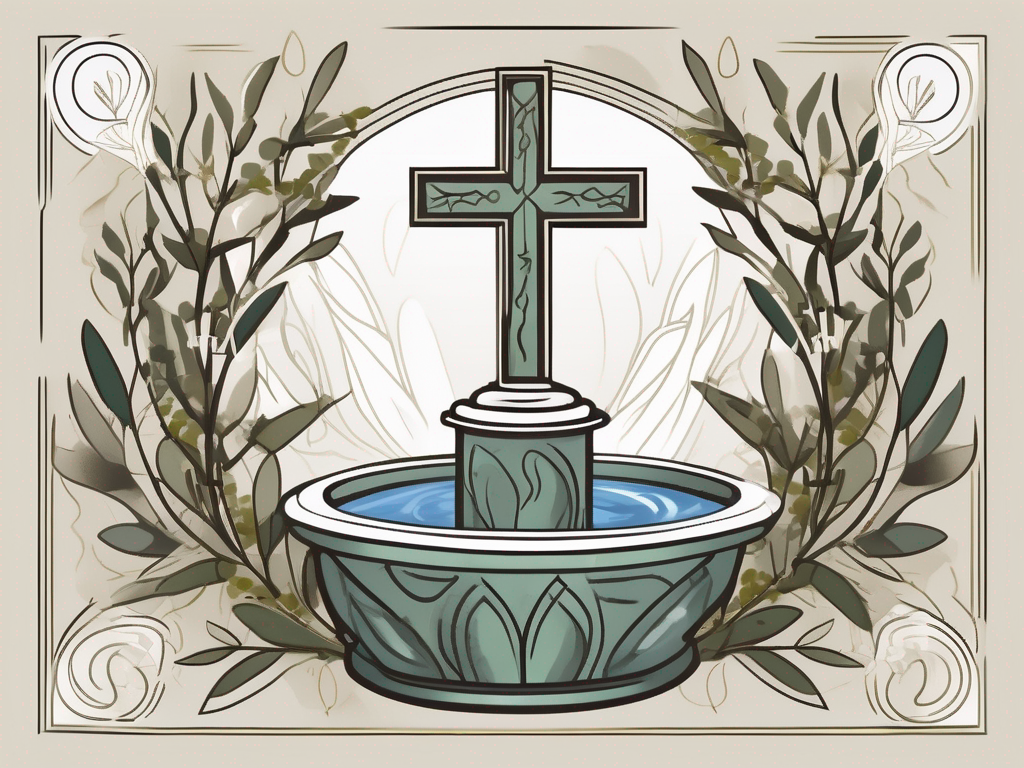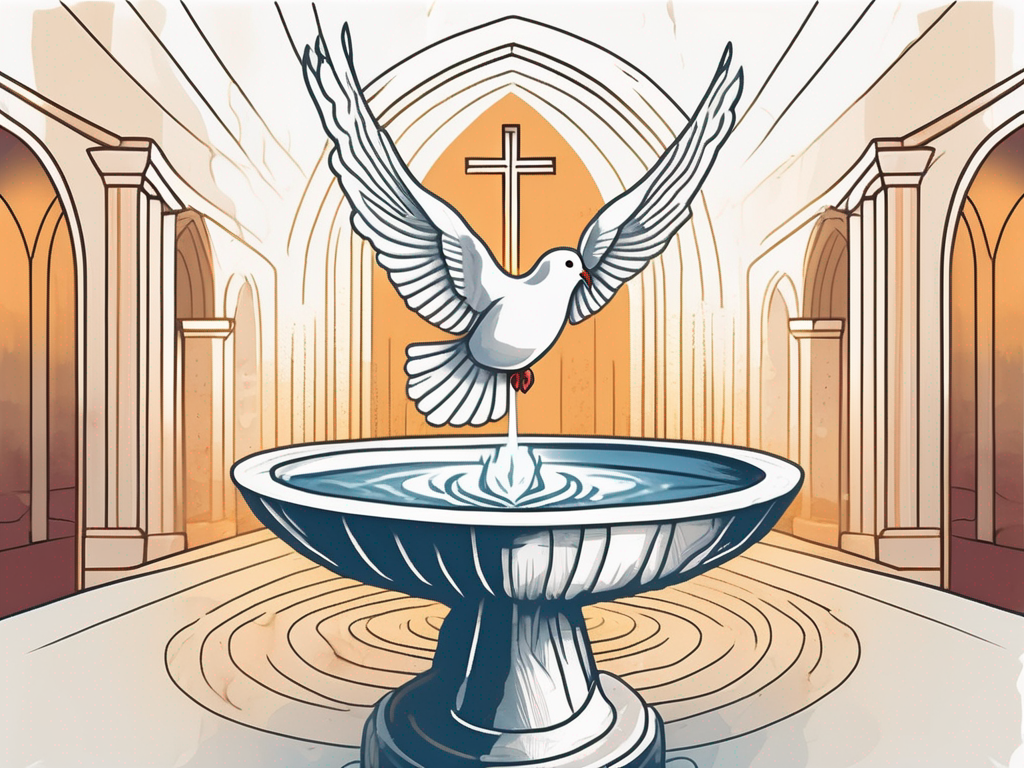Baptism is a concept that holds great significance in Christianity. It is a symbolic act performed by members of various Christian denominations, serving as a rite of initiation and a visible sign of one’s faith. In this article, we will explore what the Bible says about baptism, examining its biblical definition, symbolism, and role in the lives of believers. Additionally, we will delve into the Old Testament and New Testament teachings on baptism, as well as the different perspectives on this sacrament within Christianity.
Understanding the Concept of Baptism
Before we delve into the biblical references to baptism, let’s first grasp the concept itself. Baptism, at its core, is an act of purification and dedication. It symbolizes the washing away of sin, the dying to one’s old self, and the rising to a new life in Christ. Through baptism, Christians publicly declare their faith, acknowledging Jesus as their Lord and Savior.
When we think about baptism, it is important to consider its historical and cultural significance. In the ancient world, water was often associated with cleansing and purification. Many cultures believed that water had the power to cleanse not only the body but also the soul. In this context, baptism takes on a deeper meaning, representing a spiritual cleansing and a fresh start.
Furthermore, baptism is not a new concept introduced by Christianity. The act of water immersion or sprinkling has been practiced in various forms by different religious traditions throughout history. For example, in ancient Jewish rituals, immersion in water was a symbol of purification and a way to prepare oneself for encountering the divine.
Biblical Definition of Baptism
The Bible defines baptism as an act of water immersion or sprinkling, accompanied by a confession of faith. It is mentioned in several passages, including Matthew 3:13-17, where Jesus himself undergoes baptism in the River Jordan by John the Baptist. This event serves as an example for all believers to follow, symbolizing the acceptance of Jesus’ teachings and his mission.
When we examine the biblical references to baptism, we find that it is not just a ritual but a transformative experience. In Romans 6:3-4, the apostle Paul explains that through baptism, believers are united with Christ in his death and resurrection. This union signifies a profound spiritual change, as the old self is crucified with Christ and a new self is raised to walk in newness of life.
It is worth noting that baptism is not a requirement for salvation in Christianity. It is a symbolic act that demonstrates an individual’s faith and commitment to follow Jesus. The act of baptism does not save a person but rather serves as a public declaration of their faith in Christ.
The Symbolism of Baptism in Christianity
Beyond its literal definition, baptism carries profound symbolism. Water, in biblical context, represents cleansing and renewal. Through baptism, Christians symbolically die to their old ways, burying their former selves in the water, and rise to a new life in Christ. It signifies a spiritual rebirth, a union with Jesus, and a commitment to living a life of faith and obedience to God’s word.
Moreover, baptism is also seen as an initiation into the community of believers. It is a way for individuals to publicly identify themselves as followers of Jesus and become part of the larger body of Christ. In Acts 2:41, after Peter’s sermon on the day of Pentecost, those who believed were baptized, and about three thousand people were added to the early Christian community.
Throughout history, various traditions and practices have developed around baptism. Different Christian denominations may have variations in their understanding and practice of baptism, such as the age at which it is administered or the mode of baptism. However, the central symbolism of baptism as a spiritual cleansing and a public declaration of faith remains consistent across Christian traditions.
In conclusion, baptism is a significant sacrament in Christianity that holds deep symbolic meaning. It represents a spiritual cleansing, a union with Christ, and a commitment to live a life of faith. Through baptism, believers publicly declare their faith in Jesus and become part of the larger community of believers. It is a powerful and transformative act that continues to be practiced by Christians around the world.
Old Testament References to Baptism
The concept of baptism can also be traced back to the Old Testament, although not explicitly in the same form as practiced in Christianity. Let’s explore some instances where water played a significant role in purification rituals and symbolic acts.
Baptism in the Book of Genesis
In the book of Genesis, we find the account of Noah and the Great Flood. Through the floodwaters, God cleansed the earth from sin and offered Noah and his family a fresh start. While not explicitly referred to as baptism, this event foreshadows the cleansing aspect of the sacrament, marking a new beginning for humanity.
As the rain poured down and the floodwaters rose, Noah and his family sought refuge in the ark. Inside the ark, they were protected from the destructive power of the flood. The ark became a symbol of salvation, just as baptism is a symbol of salvation in Christianity. Through the waters of the flood, God washed away the wickedness of the world, giving humanity a chance to start anew.
Imagine the sound of rain pounding on the roof of the ark, the waves crashing against its sides. Noah and his family must have felt a mix of fear and hope as they witnessed the destruction of the old world and the promise of a new beginning. In this sense, the Great Flood can be seen as a metaphorical baptism, a purifying act that prepares humanity for a fresh start.
Symbolic Baptisms in the Prophets
Throughout the Old Testament, we come across various symbolic acts involving water that carry similarities to baptism. For instance, the Israelites passing through the Red Sea, guided by Moses, symbolizes a journey from slavery to freedom, paralleling the concepts of dying to sin and rising to a new life.
Picture the scene: the Israelites, oppressed and enslaved in Egypt, standing at the edge of the Red Sea. Behind them, the Egyptian army approaches, ready to capture or kill them. But then, a miracle happens. Moses raises his staff, and the waters of the sea part, creating a path for the Israelites to walk through.
As the Israelites walked through the parted waters, they were leaving behind their old lives of bondage and entering into a new life of freedom. The walls of water on either side of them must have been a powerful reminder of God’s presence and protection. This crossing of the Red Sea can be seen as a symbolic baptism, a moment of transformation and liberation.
In addition, the prophet Ezekiel spoke of a future cleansing, stating, “I will sprinkle clean water on you, and you shall be clean from all your uncleannesses” (Ezekiel 36:25). This image of water as a means of purification anticipates the cleansing power of baptism in Christianity.
Imagine standing in a desert, covered in dust and sweat, feeling the scorching sun on your skin. Suddenly, cool water is sprinkled over you, washing away the dirt and grime, refreshing your body and soul. This act of sprinkling clean water represents a cleansing, a purification from all impurities.
Ezekiel’s words offer hope to the people of Israel, assuring them that God will cleanse them from their sins and restore them to a state of purity. This anticipation of a future cleansing through water echoes the transformative power of baptism in Christianity, where believers are washed clean from their sins and welcomed into the family of God.
New Testament Teachings on Baptism
In the New Testament, baptism is directly connected to Jesus and his ministry. Let’s examine how the Gospels and the teachings of the Apostle Paul shed light on the significance of this sacrament.
Baptism, a sacred ritual practiced by Christians worldwide, holds deep spiritual meaning and is rooted in the teachings of the New Testament. It serves as a symbolic act of purification and initiation into the Christian faith, signifying a believer’s commitment to follow Jesus Christ.
Baptism in the Gospels
The Gospels portray baptism as an integral part of Jesus’ ministry, marking the beginning of his public mission. John the Baptist, a prominent figure in the Gospels, baptized people in the Jordan River as a sign of repentance, preparing them for the coming of the Messiah.
Jesus himself, despite being sinless, humbly submitted to John’s baptism, setting an example for his followers. This act of obedience demonstrated Jesus’ identification with humanity and his willingness to fulfill all righteousness. As Jesus emerged from the water, the heavens opened, and the Spirit of God descended upon him like a dove, while a voice from heaven declared, “This is my beloved Son, with whom I am well pleased” (Matthew 3:17).
Through his baptism, Jesus not only affirmed his divine calling but also inaugurated his redemptive work on behalf of humanity. It marked the beginning of his public ministry, where he would teach, heal, and ultimately offer himself as a sacrifice for the sins of the world.
Paul’s Teachings on Baptism
In his letters, the Apostle Paul illuminates the spiritual implications of baptism. He emphasizes that through baptism, believers are united with Christ in his death and resurrection, becoming new creations in him (Romans 6:3-4, Galatians 3:27).
Paul’s teachings highlight the transformative power of baptism. It is not merely a symbolic act but a profound spiritual experience where believers are immersed in the waters of baptism, symbolizing their identification with Jesus’ death and burial. As they rise out of the water, it represents their participation in Christ’s resurrection and the new life they have in him.
Furthermore, Paul emphasizes that baptism is not a mere ritual but a tangible expression of faith. It is an outward proclamation of an inward reality – the believer’s decision to die to their old self and be raised to new life in Christ. Through baptism, believers publicly declare their allegiance to Jesus and their desire to live in obedience to his teachings.
Paul also highlights the freedom from sin that baptism represents. As believers are united with Christ, they are set free from the power of sin and empowered to live a life of righteousness. Baptism serves as a powerful reminder of the believer’s new identity in Christ and their commitment to walk in holiness.
In conclusion, the New Testament teachings on baptism reveal its profound significance in the life of a believer. It is a sacred act that symbolizes repentance, initiation into the Christian faith, identification with Jesus’ death and resurrection, and freedom from sin. Through baptism, believers publicly declare their faith and commit to live a life that reflects the transformative power of the gospel.
The Role of Baptism in Christian Life
Baptism holds an essential role in the life of a Christian, signifying entry into the community of believers and the indwelling of the Holy Spirit. Let’s explore how baptism functions as a rite of initiation and its connection to salvation.
Baptism as a Rite of Initiation
In many Christian traditions, baptism is considered a sacrament, a sacred ritual through which believers enter into the body of Christ – the Church. It symbolizes spiritual rebirth and marks the beginning of a life dedicated to following Jesus. Through baptism, believers publicly declare their faith, witnessing before others their commitment to Christ.
Baptism and Salvation
While baptism is an essential step in the Christian journey, it is important to note that it is not the sole means of salvation. Salvation comes through faith in Jesus Christ alone. Baptism, rather, serves as an outward sign of an inward transformation that has already taken place through faith. It represents the believer’s identification with Jesus and their desire to follow his teachings.
Different Christian Perspectives on Baptism
Within the diverse landscape of Christianity, perspectives on baptism can vary. Let’s briefly explore the perspectives of Catholicism and Protestantism.
Catholic View on Baptism
In Catholic theology, baptism is regarded as a sacrament of initiation that removes the guilt of original sin and incorporates the individual into the Church. The Catholic Church recognizes the validity of both water baptism and the baptism of desire or blood, believing that baptism imparts sanctifying grace and sets the foundation for the other sacraments.
Protestant Interpretations of Baptism
Protestant views on baptism differ among denominations, but many emphasize its symbolic nature as a public profession of faith. While some denominations practice infant baptism as a means of covenantal inclusion, others advocate for believer’s baptism, which is reserved for individuals who can make a conscious decision to follow Christ.
In conclusion, the Bible speaks of baptism as a sacred act with deep spiritual significance. It symbolizes purification, new life, and the believer’s union with Christ. From the Old Testament to the New Testament, baptism is intricately woven into the biblical narrative, pointing to its importance in Christian life. Regardless of denominational differences, baptism remains a visible expression of one’s faith and a powerful reminder of God’s grace and transformative work in the lives of believers.












